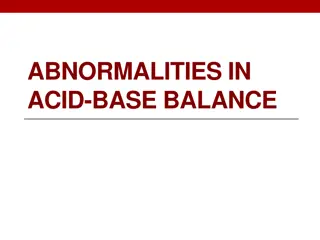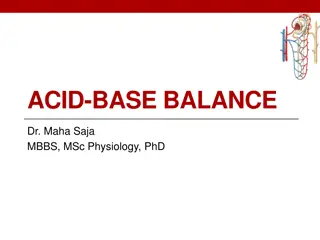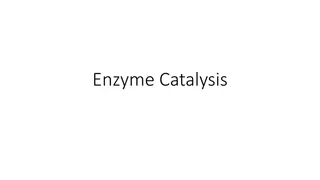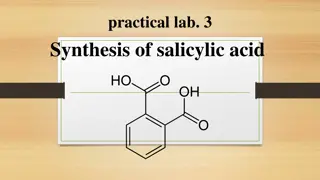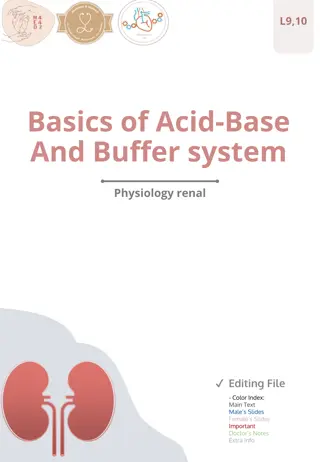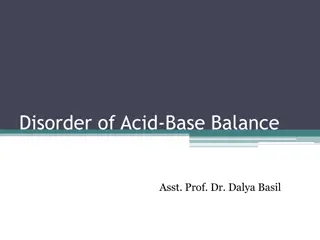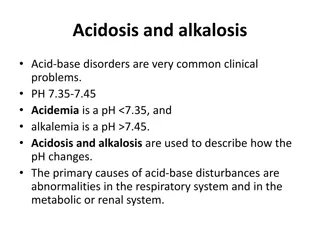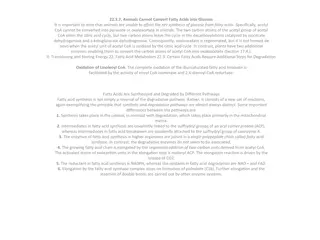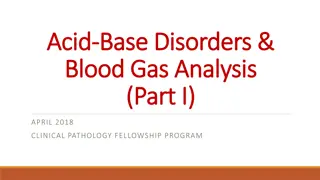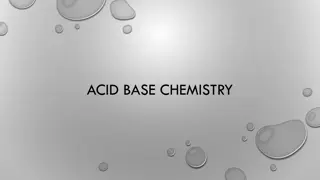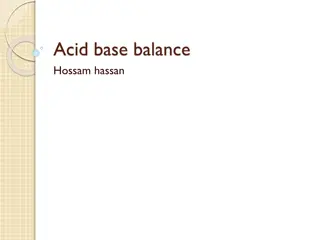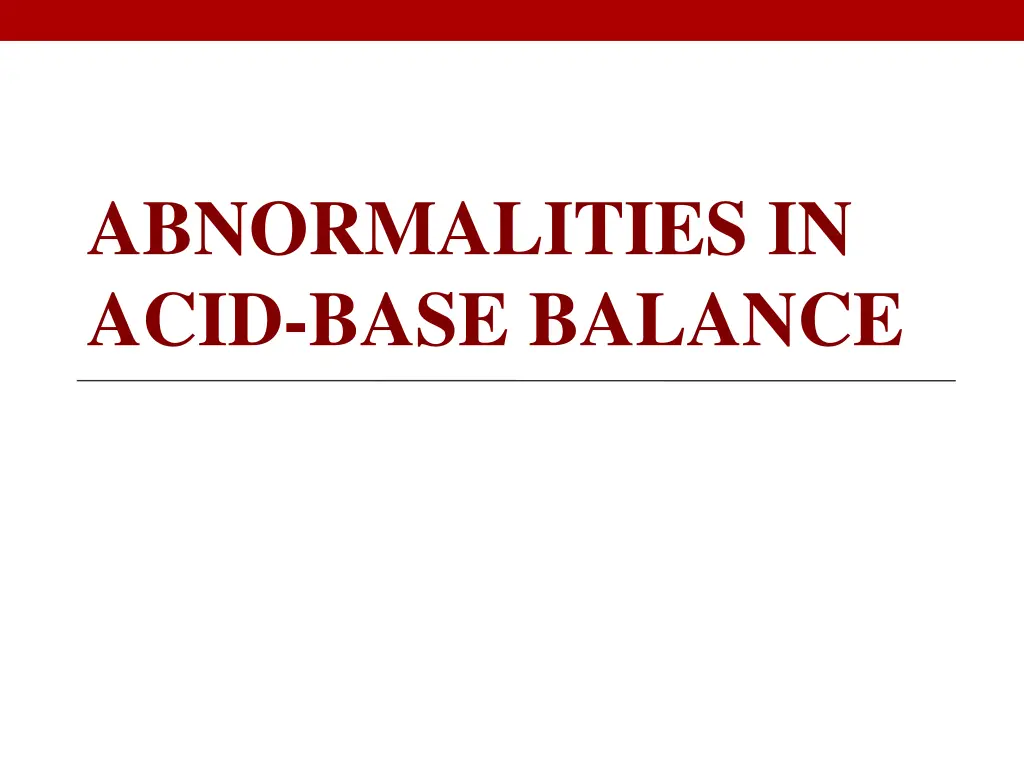
Understanding Acid-Base Balance Disorders and Management
Learn about abnormalities in acid-base balance, primary acid-base disturbances, respiratory acidosis, alkalosis, and more. Explore the fundamentals of acid-base disorders and the body's compensatory mechanisms for restoring pH balance.
Download Presentation

Please find below an Image/Link to download the presentation.
The content on the website is provided AS IS for your information and personal use only. It may not be sold, licensed, or shared on other websites without obtaining consent from the author. If you encounter any issues during the download, it is possible that the publisher has removed the file from their server.
You are allowed to download the files provided on this website for personal or commercial use, subject to the condition that they are used lawfully. All files are the property of their respective owners.
The content on the website is provided AS IS for your information and personal use only. It may not be sold, licensed, or shared on other websites without obtaining consent from the author.
E N D
Presentation Transcript
ABNORMALITIESIN ACID-BASEBALANCE
AbnormalitiesinAcid-BaseBalance Many critical illnesses can disturb acid-base balance. Acid-base disturbances may indicate an underlying disease or organ damage. Accurate interpretation of acid-base disturbances requires the following: Arterial blood gases. Plasma electrolytes. Knowledge of the compensatory physiologic mechanisms. (Appel & Downs. 2008. Understanding acid-base balance)
AbnormalitiesinAcid-BaseBalance Acidosis Alkalosis HCO3 PCO2 HCO3- HCO3- PCO2 PCO2 Respiratory Metabolic Respiratory Metabolic
FundamentalsinAcid-BaseDisorders Acid-base disorders are classified by changes in pH, PCO2 and HCO3- Thereare4primaryacid-basedisorders: Respiratoryacidosis: PCO2 Respiratoryalkalosis: PCO2 Metabolicacidosis: [HCO3-] Metabolicalkalosis: [HCO3-] The body normally attempts to correct the primary acid- base disturbances by a secondary or compensatory response trying to restore pH towards normal. Thekidneyscompensateforprimaryrespiratorydisorders. Thelungscompensateforprimarymetabolicdisorders. (Dooley & Sisson.Acid-base disorders)
PrimaryAcid-BaseDisturbances Primaryacid-base disorders Acidosis Alkalosis Respiratory Respiratory Metabolic Metabolic Increased ventilation Psychoneurosis Decreased ventilation Inhibition of respiratory center Lung damage Airway obstruction ExcessHCO3-or lossofH+ Diuretics except CAI Excess aldosterone Vomiting gastric contents Ingestion of alkaline drugs LossofHCO3-or gainofH+ Renal tubular acidosis Diarrhea Diabetes Ingestion of acids (alcohol or aspirin) Ch. renal failure
RespiratoryAcidosis Respiratory acidosis = pH + PCO2 Due to alveolar hypoventilation. Depressionof respiratorycenter Opioid ingestion Head injury Causes of Alveolar hypoventilation respiratory acidosis Lungdisease COPD Pneumonia Pulmonary edema
RespiratoryAlkalosis Respiratory alkalosis = pH + PCO2 Due to alveolar hyperventilation. Mechanical hyperventilation Causes of respiratory alkalosis Alveolar hyperventilation Anxiety
MetabolicAlkalosis Metabolic alkalosis = pH + [HCO3-] Due to loss of acids. Due to gain of HCO3- Vomitinggastric contents. DiureticsexceptCAI Hyperaldosteronism. Lossofacids Causesofmetabolic alkalosis Ingestionor administrationof alkalineproducts GainofHCO3- (Appel & Downs. 2008. Understanding acid-base balance; Dooley & Sisson.Acid-base disorders)
MetabolicAcidosis Metabolic acidosis = pH due to [HCO3-] Due to acid gain. Due to loss of HCO3 acidproduction Lactic acidosis Diabetic ketoacidosis Salicylate poisoning Starvation body acids acidelimination Renal failure Causes of metabolic acidosis Throughkidneys (RTA) HCO3 loss ThroughGIT (diarrhea) (Appel & Downs. 2008. Understanding acid-base balance; Dooley & Sisson.Acid-base disorders)
CompensatoryMechanisms PrimaryDisturbance CompensatoryMechanism RespiratoryAcidosis IncreaseHCO3 RespiratoryAlkalosis DecreaseHCO3 MetabolicAcidosis DecreasePCO2 MetabolicAlkalosis IncreasePCO2
InterpretationofAcid-BaseDisturbances Normalvalues; pH =7.35-7.45 PCO2 =35-45 mmHg HCO3-= 22-28 mmol/L
SimpleAcid-BaseDisturbances pH PCO2(mmHg) HCO3(mEq/L) Normal 7.35-7.45 35-45 22-28 Respiratory acidosis Decrease Increase Increase Respiratory alkalosis Increase Decrease Decrease Metabolic acidosis Decrease Decrease Decrease Metabolic alkalosis Increase Increase Increase
Casestudy1 A patient known to have COPD presented with 3-day history of fever, SOB, and cough productive of yellowish sputum. His ABGs showed: pH = 7.25 PCO2 = 80 mmHg. HCO3- = 34 mEq/L.
Casestudy2 A 21 year old man with IDDM presents to ER with mental status changes, nausea, vomiting, abdominal pain and rapid respirations. His ABGs showed: pH = 7.2 PCO2 = 20 mmHg HCO3 = 8 mEq/l
Casestudy3 A 2-year old child who is lethargic and dehydrated has a 3-day history of vomiting. His ABGs showed: pH = 7.56 PCO2 = 44 mmHg HCO3- = 37 mEq/l
Casestudy4 A 20-year old student suffered a panic attack while awaiting an exam. Her ABGs showed: pH = 7.6 PCO2 = 24 mmHg. HCO3 = 23 mEq/L.
OtherAcid-BaseDisorders Mixedacid-basedisorders Simpleacid-basedisorders Result from multiple primary processes. Result from a single primary abnormality with appropriate physiologic compensation.
MixedAcid-BaseDisturbances Occurs when a patient has more than one primary acid base disorder that occur at the same time. Examples: Respiratory alkalosis/acidosis along with a metabolic acidosis/alkalosis. Two metabolic acid-base disorders occurring simultaneously.
Casestudy5 A 69 year old patient had a cardiac arrest soon after return to the ward following an operation. Resuscitation was commenced and included intubation and ventilation. Femoral arterial blood gases were collected about five minutes after the arrest. Other results: Anion gap 24, Lactate 12 mmol/l. Arterial Blood Gases pH 6.85 pCO2 82 mmHg HCO3 14 mmol/l (http://www.anaesthesiamcq.com/AcidBaseBook/AB9_6Case9.php)


